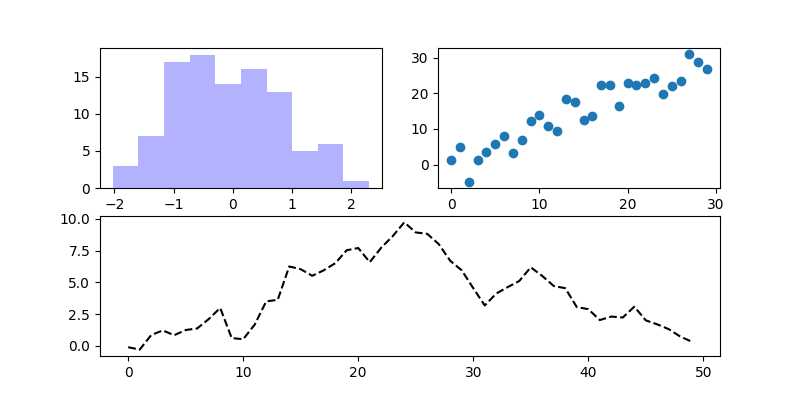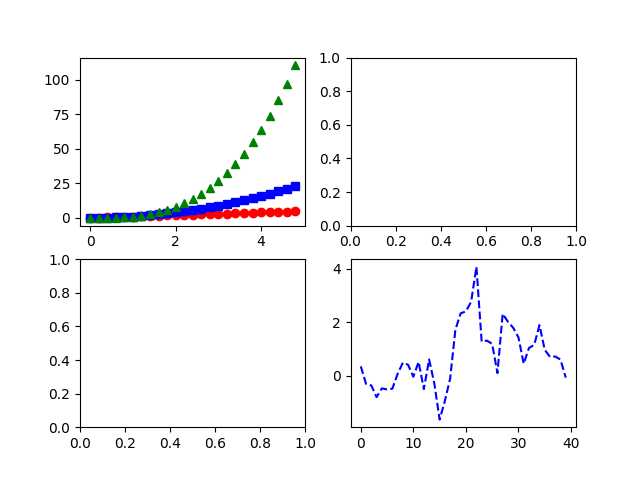标签:data 信息 创建 book str scipy div 标准 legend
在许多实际问题中,经常要对给出的数据进行可视化,便于观察。
import matplotlib.pyplot as plt
import numpy as np
from numpy.random import randn fig = plt.figure(figsize = (8,4)) #设置图的大小 ax1 = fig.add_subplot(2,2,1) ax2 = fig.add_subplot(2,2,2) ax3 = fig.add_subplot(2,1,2) ax3.plot(randn(50).cumsum(),‘k--‘) # plt.plot(randn(50).cumsum(),‘k--‘)等效 ax1.hist(randn(100),bins = 10, color = ‘b‘, alpha = 0.3) #bins 分成多少间隔 alpha 透明度 ax2.scatter(np.arange(30),np.arange(30) + 3*randn(30)) plt.show()

from numpy.random import randn fig, axes = plt.subplots(2,2) #以数组方式访问 t = np.arange(0., 5., 0.2) axes[0,0].plot(t, t, ‘r-o‘, t, t**2, ‘bs‘, t, t**3, ‘g^‘) #同时绘制多条曲线 axes[1,1].plot(randn(40).cumsum(),‘b--‘) plt.show()

使用style.use()函数
df_iris = pd.read_csv(‘../input/iris.csv‘) plt.style.use(‘ggplot‘) #‘fivethirtyeight‘,‘ggplot‘,‘dark_background‘,‘bmh‘ df_iris.hist(‘sepal length‘) plt.show()
from numpy.random import randn fig = plt.figure() ax1 = fig.add_subplot(1,1,1) ax1.plot(randn(30).cumsum(),color = ‘b‘,linestyle = ‘--‘,marker = ‘o‘,label = ‘$cumsum$‘) # 线型 可以直接‘k--o‘ ax1.set_xlim(10,25) ax1.set_title(‘My first plot‘) ax1.set_xlabel(‘Stages‘) plt.legend(loc = ‘best‘) #把图放在不碍事的地方 xticks([])设置刻度 plt.show()
等价于下面的代码:
from numpy.random import randn fig = plt.figure() ax1 = fig.add_subplot(1,1,1) ax1.plot(randn(30).cumsum(),color = ‘b‘,linestyle = ‘--‘,marker = ‘o‘,label = ‘$cumsum$‘) #图标可以使用latex内嵌公式 plt.xlim(10,25) #plt.axis([10,25,0,10])对x,y轴范围同时进行设置 plt.title(‘My first plot‘) plt.xlabel(‘Stages‘) plt.legend(loc = ‘best‘) plt.show()
from numpy.random import randn fig, axes = plt.subplots(1,2) s = pd.Series(randn(10).cumsum(),index = np.arange(0,100,10)) s.plot(ax = axes[0]) # ax参数选择子图 df = pd.DataFrame(randn(10,3).cumsum(0),columns = [‘A‘,‘B‘,‘C‘],index = np.arange(0,100,10)) df.plot(ax = axes[1]) plt.show()
from numpy.random import rand fig, axes = plt.subplots(1,2) data = pd.Series(rand(16),index = list(‘abcdefghijklmnop‘)) data.plot(kind = ‘bar‘, ax = axes[0], color = ‘b‘, alpha = 0.7) #kind选择图表类型 ‘bar‘ 垂直柱状图 data.plot(kind = ‘barh‘, ax = axes[1], color = ‘b‘, alpha = 0.7) # ‘barh‘ 水平柱状图 plt.show()
from numpy.random import rand
fig, axes = plt.subplots(1,2)
data = pd.DataFrame(rand(6,4),
index = [‘one‘,‘two‘,‘three‘,‘four‘,‘five‘,‘six‘],
columns = pd.Index([‘A‘,‘B‘,‘C‘,‘D‘], name = ‘Genus‘))
data.plot(kind = ‘bar‘, ax = axes[0], alpha = 0.5)
data.plot(kind = ‘bar‘, ax = axes[1], stacked = True, alpha = 0.5)
plt.show()
此外,柱状图有一个非常不错的用法,利用value_counts( )图形化显示Series中各值的出现概率,比如s.value_counts( ).plot(kind = ‘bar‘)。
from numpy.random import randn fig, axes = plt.subplots(1,2) data = pd.Series(randn(100)) data.hist(ax = axes[0], bins = 50) #直方图 data.plot(kind = ‘kde‘, ax = axes[1]) #密度图 plt.show()
其实可以一次性制作多个直方图,layout参数的意思是将两个图分成两行一列,如果没有这个参数,默认会将全部的图放在同一行。
df_iris = pd.read_csv(‘../input/iris.csv‘) columns = [‘sepal length‘,‘sepal width‘,‘petal length‘,‘petal width‘] df_iris.hist(column=columns, layout=(2,2)) plt.show()
df_iris = pd.read_csv(‘../input/iris.csv‘) #[‘sepal length‘,‘sepal width‘,‘petal length‘,‘petal width‘,‘class‘] sample_size = df_iris[[‘petal width‘,‘class‘]] sample_size.boxplot(by=‘class‘) plt.xticks(rotation=90) #将X轴的坐标文字旋转90度,垂直显示 plt.show()
标签:data 信息 创建 book str scipy div 标准 legend
原文地址:https://www.cnblogs.com/Allen-rg/p/8870131.html